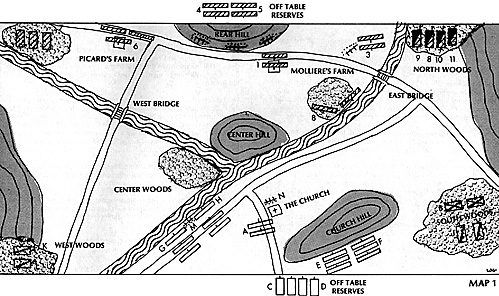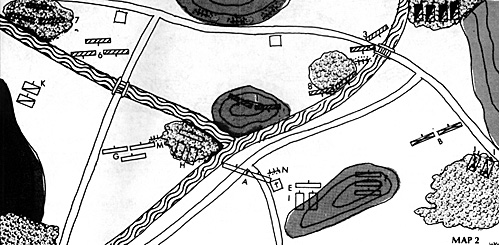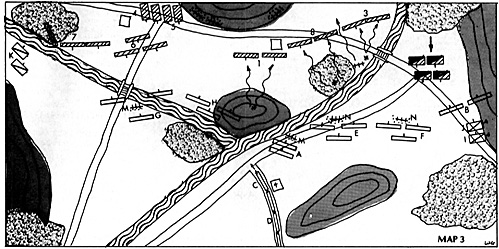 The battles of the 1870 Franco-German War have never been actively
refought by Wargamers. I have always found this to be very puzzling. All the
elements are present in this period to make for exciting tabletop games; the
colorful uniforms, lineartactics, inherent national differences, weapons variety,
and those fascinating troop types -- Algerian Turcos, Spahi Cavalry, Bavarian
Infantry, Baden Dragoons and Prussian Jaegers, Wurtemburg and Saxon
Infantry, French Marine Fusiliers, and on and on. With the advent, however, of
Frontier Miniatures tactical, battalion-level rules, "CHASSEPOT AND
NEEDLEGUN", and the flood of figures now available, I believe the Franco-
German War is about to erupt in earnest, again, at least, on tabletops in the
United States.
The battles of the 1870 Franco-German War have never been actively
refought by Wargamers. I have always found this to be very puzzling. All the
elements are present in this period to make for exciting tabletop games; the
colorful uniforms, lineartactics, inherent national differences, weapons variety,
and those fascinating troop types -- Algerian Turcos, Spahi Cavalry, Bavarian
Infantry, Baden Dragoons and Prussian Jaegers, Wurtemburg and Saxon
Infantry, French Marine Fusiliers, and on and on. With the advent, however, of
Frontier Miniatures tactical, battalion-level rules, "CHASSEPOT AND
NEEDLEGUN", and the flood of figures now available, I believe the Franco-
German War is about to erupt in earnest, again, at least, on tabletops in the
United States.
Frontier's rules reasonably reflect the major physical and moral characteristics of the two protagonists as follows: Prussian artillery is more numerous, has longer effective range, and higher hit capabilities than the French; the French rifles (the CHASSEPOT), however, outrange the Prussian needle gun (the DREYSE). French units can close into closecombat without having to check morale as the Prussians must (this reflects the ferocious, uncoordinated local counter-attacks with which the French continually plagued the Prussians in virtually every battle of the 1870 War). Prussian Command Response is 10% better than the French which allows Prussian units to react to their orders more often and consequently coordinate their movements better.
Major Army Morale (where by the more casualties an army takes increases their chances for lowering of Army efficiency) is weighted in favor of the Prussians, giving them more staying power in battle.
Cavalry of both sides is vulnerable to longer weapon ranges and has little chance of closing with, or defeating, deployed infantry or guns. These rules concepts then, successfully capture the flavor of an 1870 battle which went something like this:
The Prussians deployed their longer range artillery as soon as possible to inflict maximum casualties on the maneuvering French forces. The French, taking advantage of every piece of cover on the field, attempted to get their shorter-range guns into action. Meanwhile, their infantry was trying to close into Chassepot range before the Prussian infantry could deploy into battle lines.
Both sides tried to hold their cavalry out-of-weapon-range waiting for retiring or routed enemy infantry units to get into charge range.
This seldom occurred, though, and most Cavalry units were ultimately sacrificed to cover withdrawing or regrouping infantry formations.
Last year in Winson-Salem, North Carolina, a fictitious Franco-Prussian battle was fought on a 6'x12' game table using some 965 30mm figures. The ensuing battle typified what we think warfare of this period might have been like:
THE FORCES
- Prussian Division
- Staff & Escort
Guards Brigade
- 1. 2nd Foot Gds. (2 Btns.)
2. 8th Rhine Jaegers (2 Btns.)
Bavarian Brigade
- 3. 3rd Wurtemburg Inf. (2 Btns.)
4. 14th Bavarian Inf. (2 Btns.)
5. 15th Bavarian Inf. (2 Btns.)
29th Brigade
- 6. 33 East Prussian Inf. Rgt. (3 Btns.)
7. 60th Brandenburg Inf. Rgt. (3 Btns.)
Heavy Cavalry Brigade
- 8. Garde Cuirassiers
9. 7th Uhlans
Lt. Cav. Brigade
- 10. 2nd Baden Dragoons
11. 5th Prussian Hussars
12. Four 6-Gun Krupp Batteries
French Division
- Staff & Escort
Guards Brigade
- A. 1st Guards (2 Btns.)
B. 8th Chasseurs (2 Btns.)
Algerian Brigade
- C. 1st Turco Rgt. (2 Btns.)
D. 2nd Turco Rgt. (2 Btns.)
Second Brigade
- E. 36th Infantry (3 Btns.)
F. 48th Infantry (3 Btns.)
First Brigade
- G. 18th Infantry (3 Btns.)
H. 96th Infantry (3 Btns.)
Heavy Cavalry Brigade
- I. 9th Cuirassiers
J. 6th Lancers
Light Cavalry Brigade
- K. 3rd Hussars
L. 2nd Hussars
M. Two Mitrailleuse Batteries
N. Two 6-Gun Four 1b. Batteries
THE INITIAL SET-UP
 A tabletop terrain was built (see map) and each Army Commander was
allowed 15 minutes to study it, not knowing which side he would deploy on. The
table was then screened-off down the center with a curtain, dice were rolled to
see which army would deploy on which side, and each commander was given
30 minutes with his subordinates to plan and set-up for the battle. Each
commander had 4 infantry battalions that were to be held off the table as a late
arriving reserve force.
A tabletop terrain was built (see map) and each Army Commander was
allowed 15 minutes to study it, not knowing which side he would deploy on. The
table was then screened-off down the center with a curtain, dice were rolled to
see which army would deploy on which side, and each commander was given
30 minutes with his subordinates to plan and set-up for the battle. Each
commander had 4 infantry battalions that were to be held off the table as a late
arriving reserve force.
The on-table-units could be deployed anywhere within 18" of the table edge. Units in woods and villages, and directly behind hills, villages or woods could be considered in concealment and not placed on the table, merely recorded on paper.
After all units were placed in their initial positions on the table, each commander, in secret, rolled dice to determine on which turn his reserve force would enter the table. The sector of arrival (left, center, right) would not be known until the turn they arrived, and would be diced for. Again, refer to the map and see the initial troop dispositions for each Army.
The Prussian Commander planned essentially a defensive battle. The hill in his center, rear, was ideal for his long-ranging artillery and he placed three batteries there. (These could fire out to 54".)
On his right flank the Prussian 29th Brigade was concealed in Picard's woods and farm. The Guards Brigade was hidden in Mollieres' farm to protect the center and the Jaegers and Wurtemburgers -- with a 6 lb. Krupp battery -- were deployed covering the East bridge and Mollieres' woods.
The two Brigades of Prussian cavalry were concealed in the North Woods and were to be used as a final "counter-stroke" force for any French flanking attempt to cross the East bridge.
Four (4) Bavarian infantry battalions were scheduled to arrive on the field on the 9th turn (entry point unknown).
The Prussian Commander anticipated a major French assault against his right front at the West bridge.
The French Division Commander had other ideas. He placed cavalry in concealment on both flanks, with the Heavy Brigade in the South Woods supported with 2 battalions of Chasseurs. His major attack, and attack it would be, was across the fork of the streams at Center Hill and directly for the Prussian Rear Hill so he he deployed 14 infantry battalions and his four batteries. He knew that 4 battalions of Turcos would arrive in his rear on turn 7, and hoped they would come on in his center.
THE FIRST GAME PHASE
 (1st thru 5th turns)
(1st thru 5th turns)
As can be seen on the map, The Prussians moved out to meet the French advance and deployed North of the main stream with the Guards on Center Hill. All the while the Prussian guns took the French advance in the center under long-range fire. The Prussians planned on holding along the stream.
The French advanced all across their front trying to get into range with their Chassepots and Mitrailleuse. The light cavalry Brigade went far forward on the left to draw out any hidden fire from Picard's Woods. They were not successful; the Prussians stayed concealed and held their fire. The French Second Brigade did not keep pace with the general advance due to command problems. (They rolled bad Command Response dice during the movement phase of the turns.)
By the end of the 5th turn, the casualties of both armies were relatively light, having been inflicted primarily by long-range artillery fire. just now there were some units closing into small-arms range.
For morale purposes, at the commencement of the game, the French totalled 167 stands of figures, and the Prussians, 140. At the start of the 6th turn, the French had 13 stands off the table, and the Germans had 6. Both sides had "firm" Army Morale.
THE SECOND GAME PHASE
(6th thru 10th turns)
Looking at the map, it can be seen that the battle picked up on this phase because most of the opposing infantry got into small-arms range and close- range artillery fire.
On the French side, the Algerian Brigade of 4 battalions arrived most fortunately in the French rear-center on the 7th game turn. The French Commander used his bonus movement cards to bring up his Second Brigade in his right-center and pour fire into Mollieres' Woods while at the same time pressing his First Brigade across the streams, thru the Woods, and driving the Prussian Guards off the center hill.
From the Prussian viewpoint, this was not a good game phase. Their whole center-left-front was driven back from the stream to form line on Mollieres' farm. A six-gun battery was abandoned and the original 6 infantry battalions suffered almost 50% casualties. So threatened was the Prussian left that, you guessed it, the Commander deployed all his cavalry out of the North Woods in a desperate attack against the French rightflank to try to slow up or stop that movement.
Four Bavarian infantry battalions arrived on the 9th game turn, coming in, however, on the right-rear of the German front, where they offered no assistance in strengthening the threatened left of the line. On their right, the 29th Brigade moved out to cover the West Bridge and drove the French Light Cavalry Brigade to the rear with concentrated fire that inflicted 25% casualties on the mounted squadrons.
When the firing stopped and casualty counts were made, at the end of the loth turn the French had 45 stands (27%) off the table and the Prussians, 49 (35%). Both Armies were still in a "firm" Morale state, but the Germans were being pressed - on the ground, and with casualties.
THE THIRD (AND FINAL) GAME PHASE
(11th thru 14th turns)
 The arrival of the Bavarians allowed, in conjunction with the 60th and 33rd
German Regiments, a stabilized battle line to be deployed from Picard's Woods
to Rear Hill. This deployment stalled the advance of the French First Brigade
and the Prussian musketry, coupled with artillery fire from Rear Hill started to
severely punish these French formations.
The arrival of the Bavarians allowed, in conjunction with the 60th and 33rd
German Regiments, a stabilized battle line to be deployed from Picard's Woods
to Rear Hill. This deployment stalled the advance of the French First Brigade
and the Prussian musketry, coupled with artillery fire from Rear Hill started to
severely punish these French formations.
The French center-right, however, crossed the stream, occupied Center Hill and deployed along the North Bank and well into Mollieres' Woods, ready to advance against the weak Prussian line at the farm.
The real disaster to the Germans - even though expected, but not to this degree - was the total and devastating repulse of their 4 Regiments of Cavalry in the spoiling attack against the French right flank. As the mounted troops reeled back to the North Woods, with 2 of the 4 Regiments "routed", a quick count indicated they had taken about 75% casualties while inflicting about 15% on the French units they had assailed. This preponderance of casualties threw the Prussian Army into a "BAD" morale state with 90 stands (64%) off the table. The French were in a "shaky" morale state with only 45% (76 stands) of their stands off the table.
The German forces had actually gone into a BAD morale state at the end of the 12th turn with these ramifications; "All units with a morale of 10, and one or more stands missing, retire from the field. All other units with one or more stands missing lower their existing morale rating by 10 points." (From the rules, page 16.)
Having endured this morale breakdown for 3 turns, at the end of the 14th the Prussian Commander surrendered the field.
After battle statistics were:
| Status | French | Prussian |
|---|---|---|
| Battle Casualties | 18% | 21% |
| Routed | 8% | 14% |
| Total | 26% | 35% |
NOTE: Five Prussian mounted Staff officers were killed in action and 2 routed from the field trying to rally their units. By comparison, 3 French Staff were killed and none routed.
It was a bad day for Prussian Arms. The big question is, (excluding luck-of- the-roll), why? I would be pleased to hear from the astute readers of THE COURIER, based on this rather cursory description of the battle, where they thought the Prussian went wrong in his basic tactical plan and execution of same.
Back to Table of Contents -- Courier Vol. VII #6
To Courier List of Issues
To MagWeb Master Magazine List
© Copyright 1987 by The Courier Publishing Company.
This article appears in MagWeb (Magazine Web) on the Internet World Wide Web.
Other military history articles and gaming articles are available at http://www.magweb.com